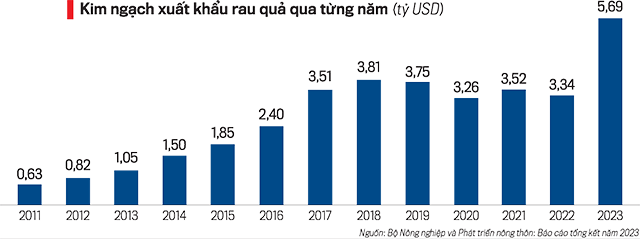In 2023, the export value of fruit and vegetables increased by 112% to reach 4.2 billion USD compared to the same period in 2022. Processed fruit and vegetable products reached nearly 1.2 billion USD, an increase of 18%. The vegetable group achieved 279 million USD, a growth rate of 4.9%. China remained the largest market in 2023 with an export value of over 3.7 billion USD, representing a 149% increase compared to 2022 and accounting for about 65.4% of the total export value of fruits and vegetables.
14 PRODUCTS WITH “VISA” TO CHINA
In just 10 months of 2023, durian exports officially surpassed the 2 billion USD mark, reaching 2.07 billion USD, an increase of 606.3% compared to the same period in 2022. In total, durian exported brought in 2.24 billion USD in 2023. Therefore, durian is currently the number one exported product in the fruit and vegetable sector.

The reason why durian achieved such a “leap” is thanks to the export declaration on durian signed between Vietnam and China in July 2022, allowing Vietnamese durian to be officially exported to the Chinese market. In 2022, durian exports were only 420 million USD, while in 2023, it reached 2.24 billion USD, a fivefold increase compared to 2022 and a tenfold increase compared to 2021.
“There is still great potential for Vietnam’s fruit and vegetable exports to the Chinese market. The “leap” of durian and some key fruit products will be an important catalyst and motivation for the Vietnamese fruit and vegetable industry to achieve the ambition of earning billions of USD and becoming a “power” in global fruit and vegetable exports.”
Mr. Nguyen Minh Tien, Director of the Agricultural Trade Promotion Center, Ministry of Agriculture and Rural Development.
According to forecasts, by 2025, the durian market in China could reach 20 billion USD, and the global market could reach 28.6 billion USD. The demand for durian in the Chinese market with a population of 1.4 billion is very high, and all durian-exporting countries in Southeast Asia still cannot meet this market demand. Meanwhile, compared to other countries in the region, Vietnamese durian has competitive advantages in terms of logistics and quality when exporting to China.
As of now, Vietnam has 14 agricultural products with an official “visa” to export to the Chinese market, including bird’s nest and bird’s nest products, sweet potato, dragon fruit, longan, litchi, mango, jackfruit, watermelon, banana, bamboo shoots, black jelly, fabric, passion fruit, and durian.
To continue opening doors for other agricultural products, Mr. Huynh Tan Dat, Director of the Plant Protection Department, Ministry of Agriculture and Rural Development, said that the department is working urgently with the General Administration of Customs of China (GACC) to complete the market opening dossier for 5 products, including fruit with pits (grapefruit, orange, tangerine…), coconut, frozen durian, chili, and medicinal herbs. If the department can successfully sign a declaration with these products, Vietnamese fruit and vegetable exports to the Chinese market will have many surprises, helping many types of fruits join the billion-dollar club in the near future.
Mr. Tran Van Duc, Chairman of the Board of Directors of Ben Tre Coconut Investment Corporation, shared that although the company’s processed coconut products have conquered high-end markets such as Europe, America, and the Middle East, they still cannot enter the Chinese market due to the lack of a declaration. Last year, Ben Tre exported 420 million USD worth of coconut, of which more than 85% were processed products. If this product can be opened to the Chinese market, achieving billions of USD from coconut exports will be completely within reach.
NOT LIMITED TO ONE MARKET
Although Vietnamese fruit and vegetable exports are “leapfrogging” into the Chinese market, Vietnam’s market share in the European Union (EU) market is still very modest. The EU is the world’s largest fruit and vegetable import market with an annual import value of up to 150 billion USD, but Vietnam’s market share accounts for only 0.18% of the total import value of the EU.
Part of the reason is that Vietnamese fruits and vegetables have not complied with the strict standards of this region. In addition, due to the lack of distribution channels owned by Vietnamese people, some Vietnamese fruits and vegetables exported to the EU are labeled with the brand of another country when consumed, which affects the brand of Vietnamese fruits and vegetables. Therefore, building the brand of Vietnamese fruits and vegetables in the EU market is a very urgent issue in the near future.
According to Mr. Nguyen Minh Tien, Director of the Agricultural Trade Promotion Center (Ministry of Agriculture and Rural Development), in order to conquer the EU market, Vietnamese fruit and vegetable exporters need to learn from the leading countries in this field. For example, Australia’s fruit, flower, and vegetable industry are considered to be heading in the right direction in achieving a 20 billion USD export value by 2030; with the current growth rate, Australia can achieve this as early as 2025-2026. To develop the fruit and vegetable industry, Australia has established a three-point policy, including improving farmers’ income; enhancing the competitiveness of fruits, flowers, and vegetables; and improving the sustainability of this industry…
The full content of the article was published in Vietnamese Economic Magazine on 7+8-2024, February 12-25, 2024. Interested readers can find it here:
https://postenp.phaha.vn/chi-tiet-toa-soan/tap-chi-kinh-te-viet-nam










































